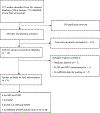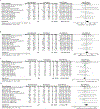Effects of respirators to reduce fine particulate matter exposures on blood pressure and heart rate variability: A systematic review and meta-analysis
- PMID: 35271952
- PMCID: PMC10411486
- DOI: 10.1016/j.envpol.2022.119109
Effects of respirators to reduce fine particulate matter exposures on blood pressure and heart rate variability: A systematic review and meta-analysis
Abstract
Particulate-filtering respirators (PFRs) have been recommended as a practical personal-level intervention to protect individuals from the health effects of particulate matter exposure. However, the cardiovascular benefits of PFRs including improvements in key surrogate endpoints remain unclear. We performed a systematic review and meta-analysis of randomized studies (wearing versus not wearing PFRs) reporting the effects on blood pressure (BP) and heart rate variability (HRV). The search was performed on January 3, 2022 to identify published papers until this date. We queried three English databases, including PubMed, Web of Science Core Collection and Scopus. Of 527 articles identified, eight trials enrolling 312 participants (mean age ± standard deviation: 36 ± 19.8; 132 female) met our inclusion criteria for analyses. Study participants wore PFRs from 2 to 48 h during intervention periods. Wearing PFRs was associated with a non-significant pooled mean difference of -0.78 mmHg (95% confidence interval [CI]: -2.06, 0.50) and -0.49 mmHg (95%CI: -1.37, 0.38) in systolic and diastolic BP (SBP and DBP). There was a marginally significant reduction of mean arterial pressure (MAP) by nearly 1.1 mmHg (95%CI: -2.13, 0.01). The use of PFRs was associated with a significant increase of 38.92 ms2 (95%CI: 1.07, 76.77) in pooled mean high frequency (power in the high frequency band (0.15-0.4 Hz)) and a reduction in the low (power in the low frequency band (0.04-0.15Hz))-to-high frequency ratio [-0.14 (95%CI: -0.27, 0.00)]. Other HRV indices were not significantly changed. Our meta-analysis demonstrates modest or non-significant improvements in BP and many HRV parameters from wearing PFRs over brief periods. However, these findings are limited by the small number of trials as well as variations in experimental designs and durations. Given the mounting global public health threat posed by air pollution, larger-scale trials are warranted to elucidate more conclusively the potential health benefits of PFRs.
Keywords: Air pollution; Blood pressure; Heart rate variability; Particulate-filtering respirators.
Copyright © 2022. Published by Elsevier Ltd.
Conflict of interest statement
Declaration of competing interest
The authors declare that they have no known competing financial interests or personal relationships that could have appeared to influence the work reported in this paper.
Figures




References
-
- Adler A, Agodoa L, Algra A, Asselbergs FW, Beckett NS, Berge E, Black H, Brouwers FP, Brown M, Bulpitt CJ, 2021. Pharmacological blood pressure lowering for primary and secondary prevention of cardiovascular disease across different levels of blood pressure: an individual participant-level data meta-analysis. Lancet 397, 1625–1636. - PMC - PubMed
-
- Bard RL, Ijaz MK, Zhang JJ, Li Y, Bai C, Yang Y, Garcia WD, Creek J, Brook RD, 2019. Interventions to reduce personal exposures to air pollution: a primer for health care providers. Global Heart 14, 47–60. - PubMed
Publication types
MeSH terms
Substances
Grants and funding
LinkOut - more resources
Full Text Sources
Medical
Miscellaneous

